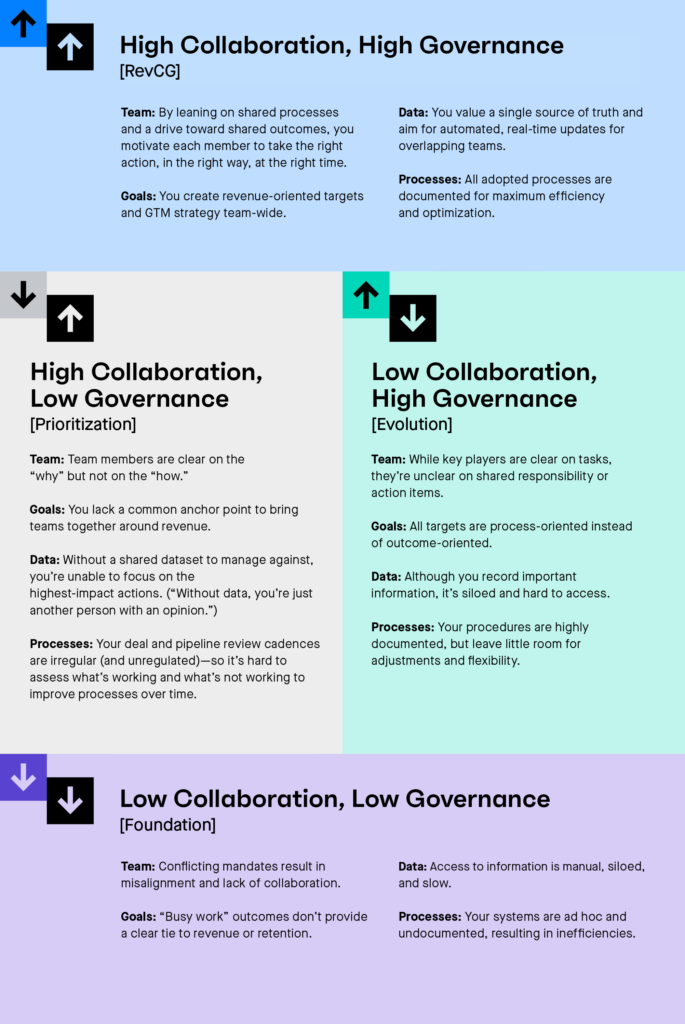Introducing the RevCG Matrix: How to Improve Your Revenue Collaboration and Governance
Subscribe to RunRevenue.Pro and get one tip for protecting your revenue — plus updates on new frameworks, playbooks, and exec conversations for running revenue like a pro — delivered straight to your inbox every Friday.
Revenue is by far the most important business process at your company.
When it’s neglected or run ineffectively, the results are devastating — the average company loses 14.9% of its revenue to preventable leaks across the revenue process (Clari Labs research, 2021).
At Clari we call this revenue leak.
But for companies who approach revenue as an end-to-end process, instead of just a number reported at the end of the quarter, the results are profound: 24% increase in win rates, 39% increase in revenue capture for committed deals, and 96% forecast accuracy on average (Clari Labs research, 2021).
Running revenue effectively requires the right balance of collaboration between teams and governance of key processes. Collaboration determines what you do; governance controls how you do it.
Collaboration determines what you do; governance controls how you do it.
Up to 50% of today’s employees are revenue-critical. But the systems they rely on are often outdated and disconnected. Collaboration between teams breaks down, and process governance is all but impossible.
Your business is demanding a new way to run revenue
It’s time to change how you prioritize collaboration without sacrificing the control that your governance has introduced—with the overarching goal to be a more dynamic revenue org.
This means:
- Creating shared processes and driving toward shared outcomes. You have what you need in place to motivate each member to take the right action, in the right way, at the right time
- Setting revenue-oriented goals that reflect the actions and collaboration of the entire GTM team
- Adopting a single source of truth for everyone, from individual reps to your VP of RevOps. You can give (and get) real-time updates for all of your overlapping teams
- Documenting efficient processes, and ensuring they’re fully adopted and adaptable
“RevCG is about getting everyone inside the GTM org to dance to the beat of the same drum by allowing complete visibility and in-depth collaboration.” – Holly Procter, SVP of Global Sales
Introducing the RevCG Matrix
There are four levels of maturity that we typically see when it comes to teams, goals, data, and processes. Each stage is outlined in a specific quadrant.
Team and Goals reflect where you stand with collaboration, while Data and Processes connect to your governance.
Skim each quadrant and see where you’d place your organization. Below that you’ll see a brief breakdown of each, including indicators and actions you can take to move toward increased collaboration and governance so you can achieve revenue precision.

Low collaboration, low governance
Indicators:
- Your SDR performance is based on meetings booked, so they’re throwing unqualified leads over the fence to your AEs—but your AE performance is based on revenue
- Deal updates are irregular and often take up large portions of your 1:1s and sales team meetings
- Forecasting is a chore, with more than a few manual (and often inaccurate) steps
- Deal inspection has moved to the back burner since it’s difficult to get the insights you need to improve
Long story, short: You’re facing quite a bit of undiagnosed revenue leak.
How to move towards revenue precision
It’s time to take your first steps toward increased collaboration and governance. You’re in a great spot to lay the foundations you’ll need to run revenue. But change doesn’t happen overnight.
Here are five steps that you can put into action right now:
- Take a step back to assess where the “breakage” lies in team collaboration. Is your team working toward quality or quantity? Are you making space for regular communication and input on deals?
- Ask yourself this question: “If someone were to game the comp system, where would they do it?” This will help you take a deeper dive into whether you’re incentivizing the right behavior.
- Identify the process or tool you need in place to gather the data you need to make informed decisions. What will take this from a reactive process to a proactive one?
- Identify one recurring check-in or step in the sales process that will help.
- Optimize what you have running already. Is it more regular deal reviews? Changing up the 1:1 agenda? Bringing in an additional person from GTM to the deal cycle?
High collaboration, low governance
Indicators:
- You can’t quickly analyze the last dozen closed/lost deals to assess what went wrong
- You can’t ask your sales managers for (and get) deal reviews as needed
- You can’t track outcomes from closed/won all the way through to retention and renewal
In other words, there’s a lot more to running revenue than your sales team working well together or playing nice with the marketing team. Collaboration is mission-critical, but governance establishes how to accomplish the mission in the first place.
Long story, short: It’s highly likely that you’re focusing on the wrong things.
How to improve your governance
If this is you, here are a few things to focus on:
- Create a “metrics glossary” to ensure people are defining key metrics the same way.
- Create a shared, up-to-date, and consistent dataset to reference, so that your revenue teams are able to focus on the highest-impact actions on a weekly basis.
- Establish a cadence for consistent reviews to assess what’s working, what’s not working, and to improve processes (and outcomes!) over time.
- Align the right data with the right goals to create effective 1:1s, team meetings, QBRs, and forecasting meetings.
Typically, Clari customers start out with very little rigor; they look at the platform as the system they need to bring governance to their collaboration.
That’s because you need both holistic, team-wide data and up-to-date data to consistently glean the insights you need for better governance. Once you have it, you’ll have a virtuous cycle on your hands: a view that focuses your attention on what needs to be governed, which in turn creates the platform for increased collaboration.
Low collaboration, high governance
Indicators:
- You may have established processes in place for these handoffs and a robust meeting cadence for team meetings—but haven’t created space for true collaboration.
- Success criteria vary across teams. Your marketing team is hyper-focused on MQLs, your SDRs are lasered in on meetings booked, your AEs put next-stage conversion above all else, and your CSMs likely feel left out of the loop altogether.
- Shared incentives don’t exist, so team-to-team hand-offs are rigid and final.
- Team goals are too short term, and too focused on a single part of the revenue process. The only team who feels accountable for closing revenue is sales.
- Data is siloed, decision making is slow, and new ideas are stymied.
- Processes are well defined, but are too rigid and inflexible. They get outdated quickly and teams lose trust.
“Are you motivating each member to take the right action, in the right way, at the right time?”
– Kyle Coleman, SVP, Marketing at Clari
Long story, short: Revenue leak happens where teams meet—and if the processes at that juncture are overly rigid and overtly siloed, the leak is probably a big one.
How to improve your collaboration
Sound like your team? Here are a few things you can start doing:
- Evolve your processes based on better insights, shared goals, and a closed feedback loop across the revenue org.
- Motivate your marketing and sales teams to collaborate on top accounts and deal acceleration (not just filling the funnel!)
- Get SDRs focused beyond opportunity creation and further into the sales cycle
- Pair AEs and CSMs to collaborate on renewal opportunities
- Intentionally and purposely blur lines of responsibility to give people more skin in the game at different times in the lead or opportunity lifecycle
High collaboration, high governance
Putting all the recommendations above into action results in peak RevCG state—working with both a high amount of collaboration and a high level of governance within your company.
Collaboration: How you run revenue.
A solid collaborative process means many different roles within the organization influence revenue: from SDRs to Sales Engineers, from AEs to CSMs, and from RevOps to sales leaders. It’s the opposite of a siloed, stage-by-stage sales process, making the entire thing more buyer-centric.
Governance: How you control revenue.
If good collaboration means you have everyone in the org dancing, good governance means you have everyone dancing to the beat of the same drum. High-quality governance means you have complete visibility into both big-picture insights and granular pieces of the life cycle.
When implemented well, the results are profound. In data science research across 2,000+ companies, Clari Labs found that companies using a RevCG strategy saw a 24% increase in win rates and a 39% increase in revenue capture for committed deals and renewals. Combined with 96% accuracy in forecasting accuracy, these companies are growth leaders.
None of that happened by accident.
The Clari Revenue Platform provides real-time, confident answers to all revenue-critical questions about your past, present, and future so you can:
- Replicate past success—and pinpoint areas of strength in your business to achieve better and more consistent outcomes
- Take action in the present—and execute with real-time insights for better outcomes today that affect tomorrow.
- Predict and hit in the future—and unlock better revenue outcomes with the most accurate forward-looking projections.
Are you ready to run revenue as a process?
There are three ways you can move towards revenue precision right now:
First: If you haven’t already taken the Revenue Leak Assessment, click here to receive your custom report. Regardless of your “score,” you’re ready for the next step on your revenue journey.
Second: Subscribe to RunRevenue.Pro for more advice, playbooks, and executive conversations for stopping revenue leak and achieving revenue precision. You’ll even get one of my tips for how to protect your revenue every Friday straight to your inbox.
Third: Adopt a true Revenue Platform, like Clari. By tying data to processes to increase your governance and motivating teams with shared goals to boost collaboration, you’ll get closer to visibility and predictability for your teams—and truly running revenue.
With Clari’s Revenue Platform, today’s revenue leak is tomorrow’s revenue precision. Ready to see higher win rates, revenue capture, and forecast accuracy?
CEO & Prime Minister of Revenue, Clari



